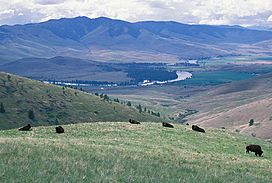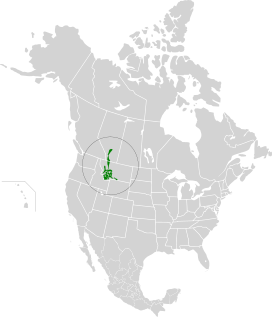Montana valley and foothill grasslands facts for kids
Quick facts for kids Montana valley and foothill grasslands |
|
|---|---|

Bison at the National Bison Range
|
|
 |
|
| Ecology | |
| Realm | Nearctic |
| Biome | temperate grasslands, savannas, and shrublands |
| Borders |
List
|
| Bird species | 214 |
| Mammal species | 88 |
| Geography | |
| Area | 31,500 km2 (12,200 sq mi) |
| Countries | United States and Canada |
| States | Montana and Alberta |
| Conservation | |
| Habitat loss | 26.375% |
| Protected | 26.85% |
The Montana valley and foothill grasslands are a special natural area. They are found in northwestern North America, stretching across parts of the northern United States and southern Canada. This area is an ecoregion, which means it's a large area of land with similar plants, animals, and climate.
Contents
What are the Montana Grasslands?
This ecoregion has rolling hills covered in grass. It also includes river valleys. These areas are located at the base of the Rocky Mountains in Montana, USA, and Alberta, Canada.
The land here is often called the Rocky Mountain Front. This is where the wide, flat Great Plains start to rise up to meet the tall Rockies. It's also close to the Continental Divide, which is like a giant line that separates rivers flowing to different oceans.
Rivers like the upper Missouri River and the Clark Fork flow through these foothills. The weather is usually mild. Warm, dry winds called Chinook winds help keep summers warm (around 14°C or 57°F). Winters are also mild for this area (around -8°C or 18°F).
Amazing Plant Life
The main plants you'll see here are grasses. Some common types include rough fescue and June grasses. But these foothills are home to many different kinds of plants. For example, in the Centennial Valley of southwest Montana, scientists have found 487 different plant species!
Some higher, drier valleys are in the rain shadow of the Rockies. This means they get less rain. Here, you'll find sagebrush plants. This habitat is similar to the nearby Snake-Columbia shrub steppe ecoregion.
The ecoregion also has parts of the Prairie Pothole Region. These are large areas with wetlands and rich grass. Historically, American bison and other grazing animals helped keep the grasslands healthy. Regular fires also played a role in renewing the plant life.
Cool Animals of the Grasslands
Long ago, huge herds of animals lived here. Explorers like Lewis and Clark saw many American bison, elk, and bighorn sheep in the early 1800s. Today, only small groups of these animals remain.
One very special animal found here is the grizzly bear. These large bears come down from the mountains to find food in the rich river areas and grasslands. This is one of the last places in the United States where grizzlies still come down to the Great Plains.
Other mammals living in these valleys include White-tailed deer, wolves, mountain lions, mule deer, pronghorn, and ground squirrels. Many birds also live here. In the Centennial Valley, you might spot grouse, sandhill crane, and trumpeter swan.
Protecting These Lands
Sadly, much of the original grassland is gone. Only about 25% remains, and even less in Canada (under 10%). This is because more and more people are moving to the Rocky Mountains.
As cities in Montana and Alberta grow, they take away natural habitats. This makes it harder for animals like grizzly bears, elk, and mule deer to move around. Areas like the Bitterroot Valley near Missoula and the Gallatin River area near Bozeman are growing very fast.
One area that needs special attention is the Clark Fork River Superfund Complex. This is a very large area along the Clark Fork River that has been affected by past mining. It includes the Berkeley Pit, which was once a copper mine. Now, it's a huge pit filled with very acidic water.
Luckily, there are still some healthy grassland and wetland areas. These include the Pine Butte Swamp Preserve near Choteau, Montana and parts of the Blackfeet Indian Reservation. Other important areas are the Centennial Mountains, the Big Hole River, and parts of the Madison River valleys.
Many places are protected to help save these grasslands. These include the Red Rock Lakes National Wildlife Refuge, Pine Butte Swamp, and the National Bison Range. There are also several Bureau of Land Management wilderness study areas that help protect this unique environment.

